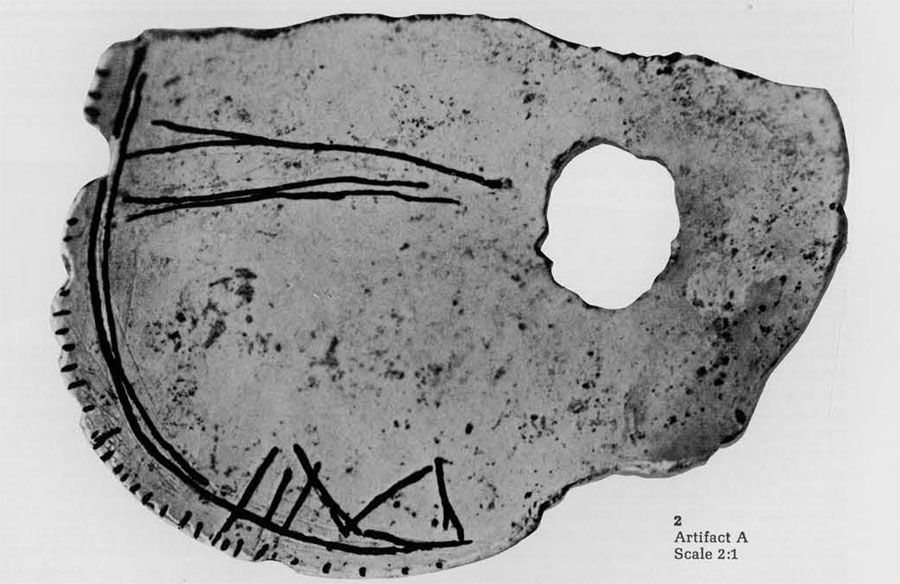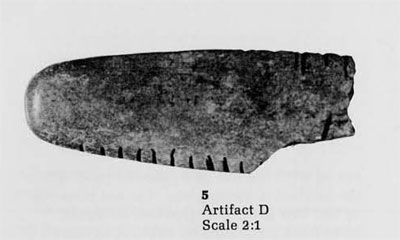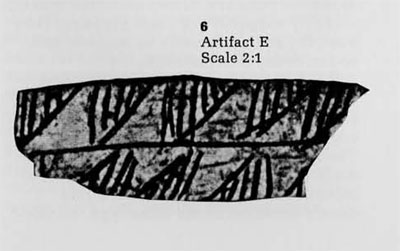
Alexander Marshack (1972) has argued that some incised designs on Old World artifacts—mainly from the Upper Palaeolithic—were notational and, in many cases, calendrical rather than simply decorative or symbolic, in a general or abstract sense. His work, much of it involving careful examination under a microscope, sets out to demonstrate three things: that these designs were sequentially incised; that different portions of a sequence were made with different individual tools; and that the sequences show regular and repeated patterns. These patterns he sees as ‘time-factored,’ many involving seasonal events, and some he claims to be lunar calendars. The frequency of these ‘time-factored’ designs, Marshack concludes, shows that this type of cognition was well-established in human beings by at least the Upper Palaeolithic period.
Prehistoric artifacts with incised designs have been reported occasionally from the middle Atlantic region of North America (Anonymous 1897; Harrington 1924; Griffin 1952; Powell 1964; Riddell 1967; Kraft and Thomas 1976), and I am aware of several others not yet published, but these are in most cases isolated finds, some lacking any secure provenience.

In 1976, however, archaeologists excavated two unusual engraved objects (artifacts A, C) at the Pipestave Hollow site, a Late Archaic habitation site on the north shore of Long Island, New York (Fig. 1). One was a section of a large whelk which had been fashioned into a pendant and, upon cleaning, revealed incised lines and what appeared to be tally marks. The other, a small, well-worn piece of deer-bone, bore similar incised markings.
The archaeological assemblage with which these artifacts were stratigraphically associated, described in more detail elsewhere (Gramly 1977), consisted of an assortment of chipped stone implements with Squibnocket Complex affiliations, together with large quantities of marine shell and other faunal detritus, which revealed that the makers of the incised objects were marine- and estaurine-oriented hunter/gatherers who exploited a beneficent and apparently stable middle-Atlantic coastal environment in the 3rd millennium B.C. A radiocarbon determination on wood charcoal from a feature on the site produced an uncalibrated date of 3965 ± 140 years BP, or approximately 2015 13.C. (GX-4530).

During the course of another summer’s fieldwork at this extensive and fruitful site, more incised bone artifacts were recovered (13, D’, E, F). A second radiocarbon determination (GX-4564, unpublished) on marine shell associated with them, closely approxi mated the 1976 date (Gramly, pers. comm.). Several of the new pieces were parts of bone flutes or whistles. Another (D) was the small, rounded end of an object similar in every detail to the 1976 bone find. Still another (F) appeared to be some sort of `tally stick,’ but others were too fragmentary for the shapes of the complete objects to be identified.
These several Pipestave Hollow pieces, all from the same site and cultural period, constitute a very unusual assemblage. It is the purpose of this essay to describe these artifacts, to ascribe function to several of them by means of analogy to similar objects reported elsewhere, and to present arguments in support of the hypothesis that some of the pieces bear lunar calendrical notations.
The Artifacts
Artifact A (from PH N2E0, Feature 2) is one of three pendants found at the site—the other two are not incised. It is a section from the shell of a marine whelk (Busycon canaliculatum), a species common in the Archaic period to the shore where the Pipe-stave Hollow site lies. The section is roughly rounded, and is pierced from the outer (convex) side with a large (12 mm. diam.) hole. Suspension as a pendant from a thong or cord is indicated, upon magnification with a Bausch and Lomb 1.5 in.-7X jeweler’s loupe, by the worn appearance of the upper edge of this hole in contrast to the rougher bottom edge. Unfortunately, the pendant is both chipped and broken, so that the design on the inner (concave)- surface is incomplete. That part of the design which is preserved is crudely rendered, much more so than the designs on some of the other Pipestave Hollow engraved pieces, indicating that the pendant was not a ‘treasure’ item, but an object of mundane use.

Short, straight ‘tally’ marks are combined on the pendant with longer lines, several of which meet to form triangles. The arrangement of these marks is reminiscent of the design on a ‘paintstone’ reported from prehistoric coastal Connecticut, at the Spruce Swamp site, no more than thirty miles northwest of Pipestave Hollow across Long Island Sound, by Powell (1964), who proposed either a ‘Southern Cult’ motif or, alternatively, the graphic representation of some meteorological or astronomical event. On analogy with certain ethnographically-known solar records, he suggested that a solar eclipse may be represented on the ‘paintstone’ with triangular `teeth’ depicted as biting the sun.
A different interpretation is equally plausible for the similar Pipestave Hollow design. Generally following Marshack, it can be supposed that the long series of hatch-marks represents days. It is not known how many are represented, because some of the marks are missing where the piece has been broken or chipped, but it is clear that, if these marks do indicate days, then somewhat more than a month is represented. Further supposing that the marks superimposed over the hatch-marks—two horizontal lines, several vertical lines, and two triangles—signify something different or special about certain of the `days’ represented by the corresponding hatch-marks (periods of ritual activity, lunar visibility or invisibility, or even periods of menstruation), the whole device might be seen as a little personal calendar, a mnemonic device perhaps worn around the neck.

Re-drawing the curved design on the pendant as a linear figure, and comparing this with a simple lunar model, following Marshack (1972: 30, fig. 3, and elsewhere), some interesting results emerge. If the superimposed marks are in some way connected to periods of lunar observation, and if the larger, central mark in the series is significant, then a continuing calendar is suggested with the central mark perhaps representing the day of invisibility of the moon. Counting in each direction from this larger mark, and placing the full moons where they would occur (13 to 15 days either side), we find that in both cases the full moons fall directly into the areas of superimposed lines, those indicating the ‘special’ days. Moreover, one full moon falls at the mark singled out by the apex of the large V on the right, while the other falls (approximately, since a few `days’ are missing due to the large chip] at the mark corresponding to the right foot of the elongated, inverse Y on the left. The design thus lends itself well to interpretation as a simple symbolic representation of the phases of the moon. Since it is incomplete, however, one cannot go further than to suggest that it is what Marshack terms a ‘lunar phrasing.’
Artifact B is a small, fragmentary object made from a bone of the white-tailed deer (Odocoileus virginianus), broken at both ends and now approximately 4 cm. in length. Some utilitarian or decorative purpose may be implied by the hole at one end: compare the bone ‘pendants’ from the Lamoka Lake site (Ritchie 1932, 1965) and the Beothuk incised bone objects reported by Marshall (1974). Microscopic examination reveals that the hole was drilled from both sides, and that its edges have been worn as if by rubbing against a thong. The piece is broken along one side as well as both ends.
The design looks decorative (this subjective problem is addressed below, in the Discussion), and there are many ethnograpically reported artifacts—especially utilitarian objects—which bear decoration of no special significance (e.g. Woodburn 1970: 20). However, the fact that within each double triangle there appears a different number of vertical lines may imply a notational system of some kind. The f rag ment is too small to yield firm conclusions, but it is interesting to note that the Moki of the American Southwest used parallel zigzag lines to symbolize lightning, and the same design with vertical lines filling the triangles—i.e. the precise design of artifact B—to represent rain-plus-lightning, or a thunderstorm (Mallery 1893:698). Because of the hole, the possibility that the artifact is part of a sighting or range-finding device must also be considered: although apparently rare, these are known in the Americas; some have tally marks which may be scales for measurement (Miles 1963:40-41). Until a future excavator unearths the remaining pieces of this artifact, however, it must remain enigmatic.
Artifact C is a heavily-engraved, handle-like object, from the limb-bone of a deer, broken at one end and now 8.5 cm. in length. It is finely wrought, smoothed on all surfaces, highly polished, and has been interpreted by its excavator as a tool, probably for “some mundane purpose,” because of what may be indications of hafting as well as its high hand-polish (Gramly 1977: 24). This assessment can be challenged on several grounds.

First, if it is a tool, it is the only decorated tool in the whole of the huge Pipestave Hollow tool assemblage. Second, although the use of deer-bone for some kinds of tools is well-documented archaeologically, its use as a substantial and often-utilized tool, in an area with a plethora of wood and stone, seems unlikely in view of the frangible nature of the material. Finally, the indications that the object was hafted are very slight. The two opposed V-shaped grooves in the undecorated side no more indicate hafting than they indicate that the object was intended to be flipped, spun, or bal anced with the use of a piece of cord. Since the artifact is incomplete, it is not possible to test this idea. The grooves, however, have been smoothed by rubbing. against something. One is reminded of gaming pieces, such as stick dice, known occasionally from the Americas (for instance, Miles 1963:211-12), which were sometimes spun or flipped with a cord. Certainly the high polish on this object, which four thousand years of burial in the soil did not obliterate, indicates that it was either purposefully rubbed or handled repeatedly. Again this is not inconsistent with the idea of a gaming piece.
The incised marks themselves, ‘tally’ marks and dots, some of which fall into regular lines, look notational, and very closely approximate the markings on an Aurignacian bone artifact from the Abri Lartet in the Dordogne which Marshack argues are lunar notations (1972:50). The seventeen hatch-marks along the edge of the rounded tip, overlain by a solid line running perpendicularly to them, mimic the `days’ marked on the whelk-shell pendant. To reinforce the suggestion that the edge-marks are a day count is the fact that, when one averages for the chipped and broken areas, the full count comes to thirty marks along one edge and fifteen along the other —highly suggestive of lunar phrasing. However, the artifact is sadly incomplete and, so far, defies interpretation.
Artifact D is a tiny (3.5 cm.), rounded, deeply-incised and highly-polished end!. fragment of a longer deer-bone object. Both edges contain hatch-marks or ‘tally’ marks. The significance of this object lies not so much in its message, for that is obviously incomplete, but in the fact that this is clearly an object of the same type, employing the same notational system, as artifact C. The importance of this coincidence has already been remarked.
I have mentioned that stick dice are known from aboriginal groups in California and the Southwest (Miles 1963:211) and elsewhere; these were made of bone or wood, were polished by repeated use, and frequently bore incised markings. Polished beaver-tooth dice, also incised, were known among the Coast Salish of British Columbia (ibid.:212), and other related groups. The smoothness of artifact D, and several other Pipestave Hollow objects evincing the unmistakable luster of repeated handling, suggests their possible use as dice or other gaming pieces. But artifact D, while highly polished, lacks wear-marks or scratches, implying a non-recreational function.
Along the edge of one side of artifact D appear ten regular marks with the suggestion, at the broken edge, of an eleventh. There is, of course, no way of knowing how many marks the series originally contained. The same edge bears the remnant, in the broken area, of what appears to have been a very long tally mark of the same series, indicating that the marks on this piece were differentiated from one another in significance. The four remaining lines, on the opposite edge, are also differentiated in length and spacing. It is unlikely, therefore, that the piece represents merely a single count, By analogy with the similar but more complete artifact C, I suggest that it is also calendrical.
The markings on artifact F resemble the five-day counts which prisoners are alleged to make on their cell walls. This piece is a small (3.5 cm.) fragment of deer-bone, broken at both ends, bearing eight groups (with the suggestion of more) of vertical marks of graduated lengths, joined by diagonal lines. The number of vertical marks in each group varies from four to seven, implying that varying-sized groups of something are represented. These marks do not suggest lunar phrasing, since this typically follows a pattern more like 7-6-3-5-7-7-7-3-5 … Following Marshack, this represents approximately seven days from full to half moon, approximately six days from half moon to invisibility, three days surrounding the day of invisibility, five days to the next half moon, and so on. However, the pattern on artifact F is, along one edge, 4-5-7-4-4 . . . If these marks are notational, they probably represent a simple tally. It is also possible, of course, that they may be purely decorative; the design does have the elements of regularity, balance, and harmony.

Artifact F is perhaps the most interesting incised object from the Pipestave Hollow assemblage. Made of deer-bone, somewhat smoothed although lacking in high polish, this object measures 8.2 cm. in length, fitting easily across the palm of the female hand. It is deeply incised along the length of one edge with markings, very few of which are alike. The other edge bears only a few marks; these, too, are different from one another. The major significance of this artifact is that here, at last, is a complete object, which the smoothly-rounded and unbroken ends attest (it was found in two pieces, and restored by R. M. Gran*, but it does not appear that any markings were obliterated by the break). The markings do not appear decorative, nor are they scrape-marks such as might be made purposely for a firmer grip, for such would be more similar to one another and presumably would extend the length of both edges.
Along one edge are twenty-nine crudely-executed but distinctive markings in a row. None of these is precisely like any other, although five are variants on a single vertical line. The grouping of the twenty-nine marks seems to fall into a 6-1-6-2-14 pattern, with the vertical-line symbols falling at the ‘1’ and ‘2’ positions of this pattern. The number 29, of course, suggests that this piece may be a one-month calendar, on which each day is represented by a separate mark.
If it is supposed that the series of marks represents one lunar month, from the first lunar crescent to invisibility, then mid-month, the period of the full moon, should fall precisely in the middle of the series, and it might be expected that the marks for these days would be differentiated in some way from the other marks. This is exactly the case. The mid-point of the series is the distinctive double-vertical marking, with thirteen marks on one side and fourteen on the other.
If the double-vertical marks in the center of the series represent the two days of the month of full lunar visibility, then it might be expected that other days of particular lunar significance, namely the days of the two half moons, would be similarly noted. Again, this hypothesis is borne out. A variant of the same vertical-line mark appears as the seventh mark from the wider (left) end of the artifact (or as the seventh mark from the proposed ‘full moon’ marks, depending on the direction in which one is `reading’: it makes no difference), e.g. on the day of the half moon.
At the other end of the series, the group of fourteen marks is unbroken by a straight-line symbol. The number of marks is precisely correct for the period of time between the full waxing and waning of the moon, but one might also expect to find the half moon indicated again about mid-way in this sequence. Instead, the two ‘days’ in the center of the sequence are marked by two X-shaped symbols, rather than the expected vertical lines. It is possible that the symbol ‘X’ represents a vertical symbol struck through as if, for instance, the observer expected to note vertical-line days of lunar significance at this point on his calendar, but was prevented from doing so, perhaps due to interfering clouds or his own failure to make the observation.
The four symbols on the opposite edge of the artifact are not in alignment with any four symbols in the long series. In addition, they are uniformly a bit bigger than the twenty-nine marks on the other edge. It is impossible to determine whether these should be considered in juxtaposition to the long series, or whether they represent the beginning of a second long series, perhaps the record of another lunar month. One hint favors the latter interpretation: the first mark of this short series, reading from left to right, may be a variant of the first mark in the long series, also reading from left to right (turning the artifact 1800 in the hand). But the series is much too short to try to interpret in the light of the evidence we have of possible lunar notation.
Discussion
The preceding sections of this article have proposed that several artifacts from the Pipestave Hollow site bear markings that may be notational or even calendrical. There are two main areas for discussion of this proposition: one, the problem of attempting to distinguish between notations on the one hand and decoration on the other, and two, the problem raised by drawing parallels between mainly Upper Palaeolithic Old World examples and considerably later New World examples.
Marshack recognizes, of course, that the distinction between notations and decoration is problematical (see, for example, Marshack 1972 pp. 35-6, 37, 38-9). His solutions for attempting to resolve the dilemma are two: first, the demonstration of replication of marking sequences on a number of artifacts (in particular by concentrating upon the longer sequences of markings) and second, his developed system of microscopic examination, which made it possible to show that some sequences were made with a whole series of different implements. For example, the Abri Blanchard bone piece bore sixty-nine markings, made with no less than twenty-four different implements. This, he argues reasonably, would be unlikely in the execution of a decorative design, but likely in a notation or calendar executed intermittently over a period of time.
At Pipestave Hollow, artifacts C and D, recovered from different loci of the site, are so similar in their markings that some specific meaning may reasonably be imputed to those markings. Further, it looks very much as if these two series of markings were not idiosyncratic, of meaning only to the maker, but intelligible to the whole community. More broadly, it may be suggested that these two artifacts, at least, are examples of a notational system widely understood in this area and period. However, it has not been possible to examine the artifacts described and discussed in this article microscopically in order to determine whether or not any or all of them were marked with more than one implement, suggesting a sequence noted over some period of time, Such detailed examination would be particularly important for Artifact F, the only complete object and therefore the only one that might carry a complete sequence.
The second major interpretative issue is of very broad significance indeed: can ancient symbolic systems be interpreted at all by cross-cultural comparison, particularly when these comparisons are across very wide gulfs of both time and space? To this reasonable doubt one may respond by referring to the critical elements of ‘structural anthropology,’ most notably the argument that there are elements common to the mental processes of all Homo sapiens sapiens, elements that appear to structure human thought and so to structure human symbols (e.g. Levi-Strauss 1962, 1963; Needham 1978,1979), Thus it follows that graphic representations of ideas are in fact limited, which greatly enhances the possibility that ancient symbolic systems can, in fact, be interpreted by modern analysts.
Conclusion
Although the Pipestave Hollow engraved artifacts are few in number, and although their analysis is incomplete, the considerations outlined in this article appear sufficient to argue that simple notational/calendrical systems were in use by Late Archaic times in northeast North America. It is hoped that this preliminary publication may stimulate other archaeologists to search for, analyze and publish further data on the prehistoric symbolic systems of this area.
